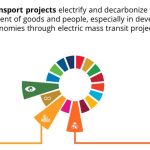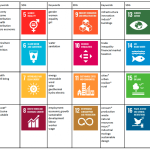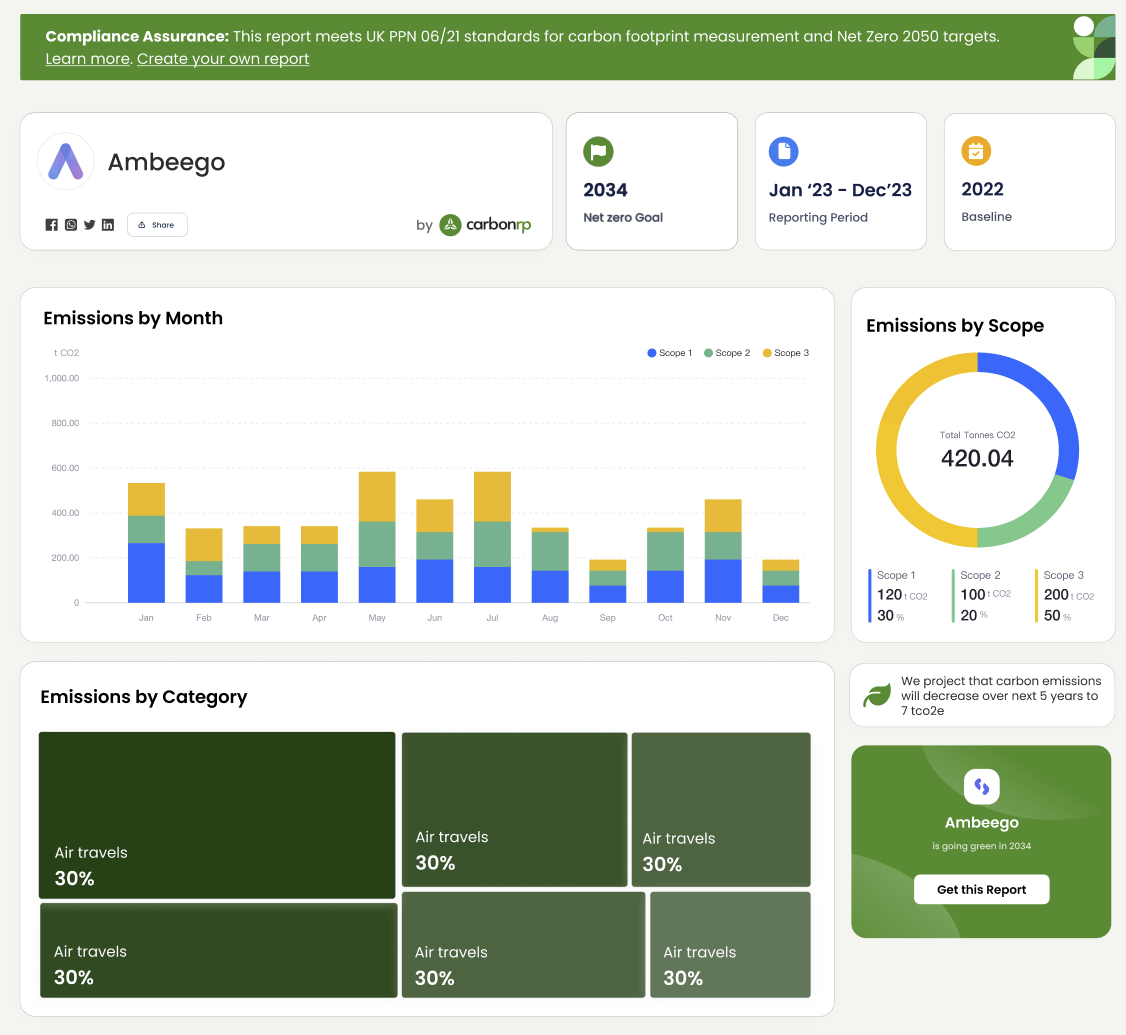In today’s environmentally conscious world, businesses are increasingly held accountable for their carbon footprint. For organizations in the UK, adhering to the Public Procurement Note (PPN) requirements for carbon offsetting is not just a regulatory obligation but also a step toward sustainability. However, generating accurate and comprehensive carbon offsetting reports can be a complex and time-consuming process. This article explores the development of a user-friendly tool designed to simplify this task. By automating data collection, calculations, and report generation, this solution aims to empower businesses to meet PPN standards efficiently, ensuring compliance while contributing to a greener future.

Feedback: Building a Tool to Easily Generate Your Carbon Offsetting Reports (PPN for UK)
Understanding the Need for Carbon Offsetting Reports
In the UK, businesses are increasingly required to provide detailed carbon offsetting reports to comply with environmental regulations and demonstrate their commitment to sustainability. These reports help organizations track their carbon emissions and outline the steps they are taking to offset their environmental impact. However, creating these reports can be time-consuming and complex, especially for companies without dedicated sustainability teams. This is where a specialized tool can make a significant difference.
Key Features of the Carbon Offsetting Report Tool
The proposed tool aims to simplify the process of generating carbon offsetting reports by offering features such as automated data collection, customizable templates, and real-time analytics. Users can input their emissions data, and the tool will automatically generate a comprehensive report that meets the standards set by the UK's Public Procurement Note (PPN). Additionally, the tool will provide recommendations for reducing emissions and improving sustainability practices.
See Also Carbon Impact- How Do Corporations Measure Impact of Their Investments in Climate Projects for Carbon Credits?
Carbon Impact- How Do Corporations Measure Impact of Their Investments in Climate Projects for Carbon Credits?Benefits of Using the Tool for UK Businesses
By utilizing this tool, UK businesses can save time and resources while ensuring compliance with environmental regulations. The tool's user-friendly interface makes it accessible to companies of all sizes, from small startups to large corporations. Moreover, the ability to generate accurate and detailed reports can enhance a company's reputation and demonstrate its commitment to sustainability, which is increasingly important to consumers and stakeholders.
Challenges in Developing the Tool
Developing a tool for generating carbon offsetting reports comes with its own set of challenges. One of the primary concerns is ensuring the accuracy and reliability of the data used in the reports. The tool must also be adaptable to the varying needs of different industries and businesses. Additionally, staying up-to-date with the latest regulations and standards, such as those outlined in the UK's PPN, is crucial to ensure the tool remains relevant and effective.
Future Enhancements for the Tool
Looking ahead, there are several potential enhancements that could be made to the tool to further improve its functionality. These include integrating with other sustainability management systems, offering multi-language support, and providing advanced analytics for deeper insights into a company's environmental impact. By continuously updating and improving the tool, it can remain a valuable resource for UK businesses striving to meet their carbon offsetting goals.
See Also Research for Master Thesis: How Hard Is It to Qualify Project for Additional SDG Impact?
Research for Master Thesis: How Hard Is It to Qualify Project for Additional SDG Impact?| Feature | Description |
|---|---|
| Automated Data Collection | Automatically gathers emissions data from various sources. |
| Customizable Templates | Allows users to tailor reports to their specific needs. |
| Real-Time Analytics | Provides up-to-date insights into carbon emissions and offsetting efforts. |
| Compliance with PPN Standards | Ensures reports meet UK regulatory requirements. |
| User-Friendly Interface | Makes the tool accessible to businesses of all sizes. |
Why Feedback is Crucial for Building an Effective Carbon Offsetting Reporting Tool
Understanding the Role of Feedback in Tool Development
Feedback plays a pivotal role in the development of any tool, especially one designed for generating carbon offsetting reports. By gathering user insights, developers can identify pain points, streamline workflows, and ensure the tool meets the specific needs of its target audience. For instance, in the context of the PPN (Public Procurement Note) for the UK, feedback from businesses and procurement teams can highlight compliance challenges, ensuring the tool aligns with regulatory requirements. This iterative process of feedback collection and implementation ensures the tool evolves into a reliable and user-friendly solution.
Key Features to Include Based on User Feedback
When building a tool for carbon offsetting reports, it’s essential to incorporate features that address user needs. Feedback often reveals the importance of automated data integration, customizable report templates, and real-time analytics. For example, users may request the ability to import data directly from energy consumption trackers or supply chain management systems. Additionally, feedback can highlight the need for multi-user collaboration features, allowing teams to work together seamlessly. By prioritizing these features, the tool becomes more efficient and aligned with the PPN guidelines for the UK.
How Feedback Enhances Compliance with PPN Guidelines
The Public Procurement Note (PPN) in the UK sets specific requirements for carbon offsetting and reporting. Feedback from users ensures the tool not only meets these guidelines but also simplifies the compliance process. For instance, users may suggest incorporating pre-built templates that align with PPN standards or adding validation checks to ensure data accuracy. By integrating these suggestions, the tool becomes a trusted resource for businesses striving to meet regulatory obligations while reducing their carbon footprint.
See Also Double Counting Issues Within VCMs: How High Is the Risk?
Double Counting Issues Within VCMs: How High Is the Risk?The Importance of User Testing and Iterative Feedback Loops
User testing is a critical phase in the development of any tool, and carbon offsetting reporting tools are no exception. Through iterative feedback loops, developers can refine the tool’s functionality and usability. For example, initial testing might reveal that users struggle with data input processes or find certain features unintuitive. By addressing these issues through continuous feedback, the tool becomes more accessible and effective. This approach also fosters a sense of user ownership, as stakeholders feel their input directly shapes the tool’s evolution.
Leveraging Feedback to Improve User Adoption and Engagement
A tool’s success ultimately depends on its adoption rate and user engagement. Feedback helps identify barriers to adoption, such as complex interfaces or lack of training resources. By addressing these concerns, developers can create a tool that is not only functional but also user-friendly. For instance, incorporating onboarding tutorials or interactive guides based on user feedback can significantly enhance the user experience. Additionally, feedback can reveal opportunities to add gamification elements, such as progress tracking or achievement badges, to encourage consistent use and engagement.
By focusing on feedback-driven development, the tool becomes a powerful ally for businesses navigating the complexities of carbon offsetting reporting under the PPN for the UK.
Frequently Asked Questions (FAQ)
What is the purpose of the PPN tool for generating carbon offsetting reports?
The PPN tool is designed to simplify the process of creating carbon offsetting reports for organizations in the UK. It helps businesses comply with environmental regulations by providing an easy-to-use platform that automates data collection, analysis, and report generation. This ensures that companies can accurately measure their carbon footprint and take actionable steps to offset their emissions effectively.
How does the PPN tool ensure accuracy in carbon offsetting reports?
The PPN tool leverages advanced algorithms and data validation techniques to ensure the accuracy of carbon offsetting reports. It integrates with various data sources, such as energy consumption records and transportation logs, to provide a comprehensive overview of an organization's emissions. Additionally, the tool adheres to UK-specific guidelines and standards, ensuring that all reports meet regulatory requirements.
Can the PPN tool be customized for different industries?
Yes, the PPN tool is highly customizable and can be tailored to meet the specific needs of various industries. Whether you're in manufacturing, logistics, or retail, the tool allows you to input industry-specific data and generate reports that reflect your unique carbon footprint. This flexibility ensures that businesses across different sectors can effectively manage their environmental impact.
What are the benefits of using the PPN tool for carbon offsetting reports?
Using the PPN tool offers several benefits, including time savings, improved accuracy, and regulatory compliance. The tool automates the entire reporting process, reducing the need for manual data entry and minimizing the risk of errors. It also provides actionable insights that help businesses identify areas for improvement and implement effective carbon reduction strategies. Ultimately, the PPN tool supports organizations in achieving their sustainability goals while maintaining compliance with UK regulations.
Leave a Reply


Our Recommended Articles